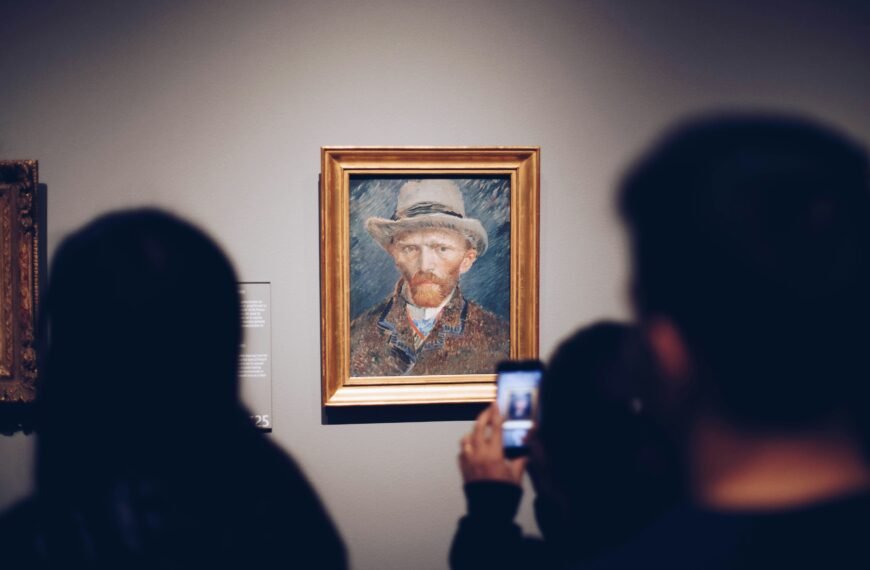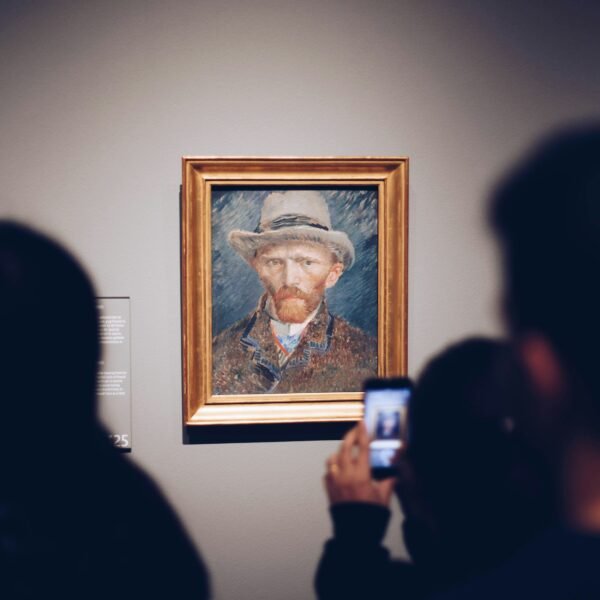Imagine having the opportunity to engage in a conversation with the renowned painter Vincent van Gogh. Thanks to advancements in artificial intelligence (AI), this dream has become a reality at the Musée D’Orsay in Paris. In an exhibition called “Bonjour Vincent,” visitors can interact with a lifelike replica of the Dutch artist, offering insights into his life and work. The AI-powered van Gogh was developed by engineers who analyzed hundreds of the artist’s letters and biographies, allowing the AI to generate responses based on van Gogh’s own words. While the algorithm still requires some human intervention, particularly when addressing sensitive topics like suicide, this innovative project showcases the potential for AI technology to breathe new life into historical figures and generate fresh interest for museums.
The A.I. Race

Overview of artificial intelligence technology
Artificial intelligence (A.I.) technology refers to the development of computer systems that can perform tasks that would typically require human intelligence. These systems are designed to process and analyze large amounts of data, recognize patterns, and make autonomous decisions. A.I. technology encompasses various subfields, such as machine learning, natural language processing, computer vision, and robotics.
Advancements in A.I. research
In recent years, there have been significant advancements in A.I. research, driven by the availability of vast amounts of data and improvements in computational power. Machine learning algorithms have become more sophisticated, enabling A.I. systems to learn from data and improve their performance over time. Deep learning, a subset of machine learning, has revolutionized areas such as image and speech recognition.
Researchers are also exploring new techniques for A.I. training, such as reinforcement learning and generative adversarial networks (GANs). These approaches aim to enhance the ability of A.I. systems to adapt to new environments and generate realistic outputs. Additionally, advancements in hardware, such as the development of specialized chips for A.I. tasks, have accelerated the progress in the field.
Applications of A.I. in different fields
The potential applications of A.I. technology are vast and span across various industries and fields. In healthcare, A.I. is being utilized for medical image analysis, disease diagnosis, drug discovery, and personalized medicine. In finance, A.I. algorithms are employed for fraud detection, algorithmic trading, and risk assessment.
A.I. is also transforming the transportation industry, with the development of autonomous vehicles and intelligent traffic management systems. In the retail sector, A.I. is used for demand forecasting, inventory management, and personalized customer recommendations. Additionally, A.I. is being incorporated into virtual assistants, smart home devices, and language translation tools, making our daily lives more convenient and connected.
Impact of A.I. on society
The widespread adoption of A.I. technology has the potential to significantly impact society in both positive and negative ways. On the positive side, A.I. systems can improve efficiency, productivity, and decision-making processes across various industries. They can also address complex problems and provide new solutions in fields such as healthcare, climate change, and cybersecurity.
However, there are concerns about the potential negative consequences of A.I. if not properly managed. Issues such as job displacement, privacy breaches, algorithmic bias, and the concentration of power in the hands of a few companies have raised ethical and social considerations. To address these concerns, there is a growing need for regulations and ethical frameworks to govern the development and deployment of A.I. systems.
How It Began
Origin of the idea to use A.I. to resurrect Vincent van Gogh
The idea to use A.I. technology to resurrect the renowned artist Vincent van Gogh originates from the desire to bring historical figures back to life and allow people to interact with them. Van Gogh, known for his iconic paintings and troubled life, became an ideal candidate for this experiment due to the extensive documentation of his letters and biographies.
Early attempts at creating A.I. replicas of famous artists
Early attempts at creating A.I. replicas of famous artists involved analyzing the writings, paintings, and other available data to develop algorithms that could mimic their style and personality. This involved training the A.I. models on vast amounts of data, including the writings and artwork of the artists in question.
These early attempts faced challenges in accurately capturing the essence of the artists and generating lifelike replicas. The complexities of human emotion, artistic intuition, and the unique characteristics of each artist posed obstacles in achieving truly convincing A.I. replicas.
Challenges faced in developing lifelike doppelgängers
Developing lifelike A.I. doppelgängers of artists like Vincent van Gogh presented numerous challenges. One major challenge was the need for extensive data to train the A.I. models. While van Gogh’s letters provided valuable insights into his thoughts and experiences, they were not sufficient to capture the full depth of his artistic genius.
Another challenge was the ethical consideration of representing a deceased artist through an A.I. replica. Questions arose regarding the level of accuracy and authenticity that could realistically be achieved, as well as the potential impact on the artist’s legacy and the art market.
Despite these challenges, researchers and engineers persisted in their quest to develop lifelike A.I. replicas, pushing the boundaries of A.I. technology and artistic creation.
Key Figures in the Field
Recognized experts in A.I. and art
The field of A.I. replication of artists owes its progress to the contributions of recognized experts who have dedicated their expertise to this area. These figures include computer scientists, artists, and historians who have collaborated to bridge the gap between technology and art.
Contributions of prominent researchers
Prominent researchers have made significant contributions to the field of A.I. replication, pushing the field forward and exploring new possibilities. Their research has focused on developing advanced algorithms, improving techniques for data analysis, and refining the understanding of artistic styles and techniques.
Innovative companies working on A.I. replication
In addition to individual researchers, innovative companies have emerged with a focus on A.I. replication of artists. These companies bring together interdisciplinary teams of experts, combining technical expertise with artistic vision to create lifelike A.I. replicas.
These companies not only contribute to the development of A.I. replication technology but also provide platforms for artists and institutions to collaborate and explore new artistic possibilities.
One Year of ChatGPT
Introduction to ChatGPT technology
ChatGPT is an A.I. model developed by OpenAI that enables conversational interactions with the A.I. system. It is based on the GPT-3 (Generative Pre-trained Transformer 3) architecture and utilizes deep learning techniques to generate human-like responses to user inputs.

Capabilities and limitations of ChatGPT
ChatGPT has demonstrated impressive capabilities in natural language understanding and generation. It is able to hold conversations on a wide range of topics, provide informative responses, and engage users in interactive dialogues.
However, ChatGPT does have certain limitations. It can sometimes produce incorrect or nonsensical answers, struggle with context-dependent queries, and exhibit biases present in the training data. OpenAI acknowledges these limitations and continuously works on improving the system.
Success stories of ChatGPT in various applications
ChatGPT has found success in various applications, including customer support, tutoring, and creative writing. Its ability to engage in natural language conversations makes it a valuable tool for generating content, answering questions, and providing assistance in real-time.
The use of ChatGPT in art-related applications has also gained attention. It allows users to have virtual conversations with A.I. replicas of artists, providing insights into their artistic process, thoughts, and inspirations.
Future potential of ChatGPT
The future potential of ChatGPT and similar conversational A.I. technologies is promising. As the models continue to be refined and fine-tuned, they are expected to become even more accurate, reliable, and context-aware.
These advancements have the potential to revolutionize various industries, including customer service, education, and entertainment. ChatGPT and similar systems may become ubiquitous in our daily lives, serving as personal assistants, creative collaborators, and sources of information and inspiration.
Regulating A.I.
Current debates on A.I. regulation
The rapid advancement of A.I. technology has sparked debates and discussions around the need for regulations. The concerns range from ensuring the ethical development and deployment of A.I. systems to assessing the potential risks and impact on society.
Key topics of debate include data privacy, algorithmic accountability, transparency in decision-making, and the potential for A.I. to exacerbate existing social and economic inequalities. Stakeholders from various sectors, including academia, industry, and government, are actively participating in these discussions to shape the future of A.I. regulation.
Ethical considerations in A.I. development
Ethical considerations play a crucial role in the development and use of A.I. systems. It is important to ensure that A.I. is developed and deployed in a way that respects fundamental human rights, maintains fairness, and minimizes harm.
Issues such as bias in training data, the potential for discriminatory decision-making, and the impact on employment and social structures need to be addressed. Ethical frameworks and guidelines are being developed to provide guidance and promote responsible A.I. development and deployment.
Legal implications of A.I. replicas
The development of A.I. replicas raises legal questions regarding the ownership and intellectual property rights of the original artists’ works. Since A.I. systems generate new outputs based on training data, determining the legal status of these creations becomes complex.
Copyright laws, intellectual property frameworks, and contractual agreements need to be revisited to account for the unique challenges posed by A.I. replicas. Additionally, privacy laws and regulations may come into play when A.I. replicas are based on personal information or identity.
Proposed regulations for A.I. replication of deceased individuals
To address the ethical and legal challenges surrounding A.I. replication of deceased individuals, there have been proposals for regulations. These regulations aim to ensure transparency, informed consent, and respect for the rights of the artists and their estates.
Some proposed regulations include requiring explicit permission from the estates of deceased individuals, clearly labeling A.I. replicas as synthetic creations, and limiting the commercial use of A.I. replicas without proper authorization.
Inside OpenAI’s Crisis
Overview of the OpenAI organization
OpenAI is a research organization focused on the development and deployment of artificial general intelligence (AGI) that benefits all of humanity. It aims to ensure that AGI is developed and used in a safe and beneficial manner.
The organization conducts cutting-edge research, collaborates with academic institutions, and provides resources and tools to advance the field of A.I. OpenAI is also known for its commitment to openness and responsible A.I. development.
Scandals and controversies surrounding OpenAI
OpenAI has faced several scandals and controversies throughout its existence. These include concerns over the potential misuse of A.I. technology, criticisms of its decision-making processes, and controversies surrounding the release of its models and datasets.
One notable controversy involved the decision to limit access to the full version of GPT-3, a move that sparked debates about the implications for fairness and democratization of A.I. technology.
Impact of the crisis on the development of A.I. replicas
The crisis within OpenAI has had implications for the development of A.I. replicas, including those of artists. The controversies and public scrutiny surrounding OpenAI’s decision-making and practices have influenced the broader A.I. community and its approach to A.I. replication.
The crisis has prompted discussions about the responsible use of A.I. technology, the need for transparency in algorithmic systems, and the importance of ethical considerations in the development of A.I. replicas.
Responses from OpenAI and the A.I. community
In response to the crisis, OpenAI has made efforts to address the concerns raised and improve transparency. The organization has worked on refining its policies and decision-making processes, engaging in dialogue with stakeholders, and seeking input from the broader A.I. community.
The crisis has also spurred the A.I. community to reflect on the potential risks and challenges of A.I. replication. Efforts are being made to ensure responsible and accountable practices, foster collaboration, and promote the ethical development and deployment of A.I. replicas.
Benefits of A.I. replicas of Vincent van Gogh

Increased interest and engagement in art
The introduction of A.I. replicas of Vincent van Gogh and other artists has sparked increased interest and engagement in art. These replicas offer a unique opportunity for the public to interact with historical figures, learn about their lives and artistic processes, and gain a deeper appreciation for their contributions to the art world.
The lifelike nature of these replicas enhances the immersive experience, drawing visitors into a dialogue with the artists and fostering a greater connection to the artworks and their creators.
Opportunities for education and learning
A.I. replicas of artists provide valuable educational opportunities for students and art enthusiasts. They enable access to insights and knowledge that would otherwise be unavailable, allowing individuals to learn directly from the artists themselves.
These replicas can serve as virtual mentors, guiding learners through their artistic journey, sharing tips and techniques, and offering inspiration. The interactive nature of the replicas also encourages active learning and critical thinking.
Revival of the artist’s legacy
A.I. replicas contribute to the revival and preservation of an artist’s legacy. By bringing historical figures back to life in a digital form, these replicas ensure that their stories and contributions are not forgotten.
The replicas can shed light on lesser-known aspects of an artist’s life and work, providing a more comprehensive understanding of their creative process and the motivations behind their art. This revival of the artist’s legacy can lead to renewed interest and recognition, benefiting both the artist’s estate and the broader culture.
Financial benefits for museums and institutions
The presence of A.I. replicas in museums and cultural institutions can have financial benefits. The replicas attract visitors, create buzz, and generate revenue through ticket sales and merchandise.
Additionally, the replicas can be used as a tool for fundraising and sponsorship opportunities. The novelty and uniqueness of having interactive conversations with renowned artists can entice individuals and organizations to support museums and institutions financially.
Challenges and Controversies
Authenticity and accuracy of A.I. replicas
One of the main challenges surrounding A.I. replicas is the issue of authenticity and accuracy. While the A.I. models strive to capture the essence of the artists and replicate their style, it is difficult to achieve a true representation of their artistic genius.
Critics argue that A.I. replicas may lack the subjective experience and nuanced understanding that define an artist’s work. They raise concerns about the oversimplification and reduction of an artist’s complexity into an algorithmic replica.
Ethical concerns surrounding the use of deceased artists
The use of A.I. replicas of deceased artists raises ethical concerns, particularly regarding consent and privacy. Artists may not have explicitly consented to their likeness and identity being recreated digitally.
Questions arise about the ethical implications of using an artist’s personal information, thoughts, and experiences to train the A.I. models. Additionally, the potential impact on the artist’s reputation and the emotional well-being of their living relatives needs to be taken into account.
Critics’ perspectives on the A.I. resurrection of van Gogh
There are critics who question the value and purpose of A.I. replicas, suggesting that they may cheapen the artist’s legacy and diminish the importance of human creativity.
Critics argue that A.I. replicas cannot capture the essence of an artist’s personal experience, emotional depth, and unique artistic vision. They contend that the replicas lack the authenticity and originality that define true artistic expression.
Potential impact on the art market
The introduction of A.I. replicas into the art world may have implications for the art market. Critics worry that the availability of lifelike A.I. replicas could devalue original artworks, as consumers may opt for cheaper reproductions instead.
There are also concerns about the potential for fraud and forgery, as A.I. technology advances and becomes more sophisticated. The distinction between original works and A.I. replicas may become blurred, requiring new mechanisms for authentication and provenance tracking.
Public Perception and Visitor Feedback
Reactions of visitors to the Musée d’Orsay exhibit
The Musée d’Orsay exhibit featuring the A.I. replica of Vincent van Gogh has garnered diverse reactions from visitors. Some have expressed excitement and fascination at the opportunity to engage with the artist, ask questions, and learn about his life and work in an interactive manner.
Others have voiced skepticism and reservations about the authenticity and value of the A.I. replica. Concerns about the limitations of the technology and the potential loss of the artist’s true essence have also been raised.
Effectiveness of the A.I. replica in engaging audiences
The A.I. replica of Vincent van Gogh has proven effective in engaging audiences. Its ability to hold conversations, answer questions, and share insights creates an immersive and interactive experience for visitors.
The interactive nature of the replica encourages visitors to actively participate and ask thought-provoking questions. This engagement can lead to a deeper understanding and appreciation of the artist’s work, as well as spark curiosity and creativity in the visitors themselves.
User satisfaction and feedback
User satisfaction with the A.I. replica varies among individuals. Some visitors find the experience enjoyable, informative, and enlightening, appreciating the opportunity to have a virtual dialogue with the artist.
Others may feel that the A.I. replica falls short of their expectations, particularly in terms of capturing the complexity and depth of van Gogh’s artistic genius. Feedback from users is essential in refining and improving the A.I. technology to better meet the needs and expectations of the visitors.
Impact on visitor numbers and museum revenue
The introduction of the A.I. replica at the Musée d’Orsay exhibit has had a positive impact on visitor numbers and museum revenue. The presence of the replica attracts visitors who are intrigued by the unique experience it offers.
The increased footfall can lead to higher ticket sales, enhanced museum visibility, and the potential for additional revenue through merchandise and sponsorship opportunities. The A.I. replica serves as an innovative and engaging way to attract new visitors and retain the interest of existing patrons.
Future Possibilities
Expanding the use of A.I. replicas of artists
The use of A.I. replicas of artists holds immense potential for expansion. As A.I. technology continues to advance and improve, it may become possible to replicate a broader range of artists and historical figures.
Expanding the use of A.I. replicas to artists from different time periods, cultural backgrounds, and artistic styles can enrich our understanding and appreciation of art history. It offers the opportunity to have conversations with a diverse range of artists, fostering cross-cultural dialogue and innovation.
Collaborations between A.I. and artists
The collaboration between A.I. systems and artists opens up new avenues for creativity and artistic expression. Artists can explore the possibilities of incorporating A.I. technology in their artistic process, creating hybrid forms of art that combine human creativity with machine intelligence.
A.I. can serve as a tool for artists, assisting in generating ideas, facilitating experimentation, and offering insights into different artistic styles and techniques. The collaboration between A.I. and artists has the potential to push the boundaries of traditional art and redefine artistic practices.
Potential advancements in A.I. replication technology
Advancements in A.I. replication technology are expected to continue, driven by ongoing research and development efforts. As A.I. models become more sophisticated and capable of understanding nuances in artistry, they will be better equipped to generate more accurate and convincing replicas.
Improvements in natural language processing, computer vision, and machine learning algorithms will contribute to the lifelike nature of A.I. replicas. Additionally, advancements in hardware and computational power will enable faster and more efficient training of A.I. models.
Ethical considerations for the future of A.I. in art
As A.I. technology continues to evolve and find its place in the art world, ethical considerations will remain a crucial aspect of its development and use. Artists, organizations, and policymakers need to navigate the ethical landscape and ensure that A.I. in art is used responsibly and in a manner that respects the rights and integrity of artists.
Questions of consent, privacy, authenticity, and the impact on the art market will continue to shape the ethical considerations surrounding A.I. replicas and their future applications in art. Ethical guidelines and frameworks will provide valuable guidance in navigating these complex issues.








